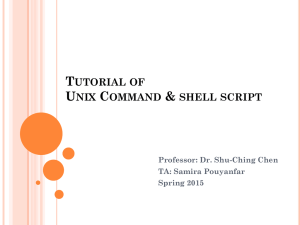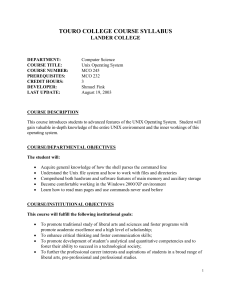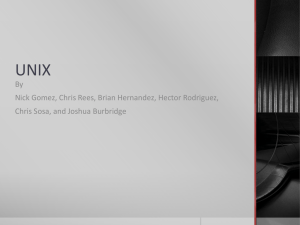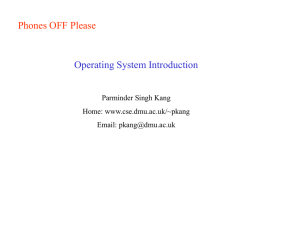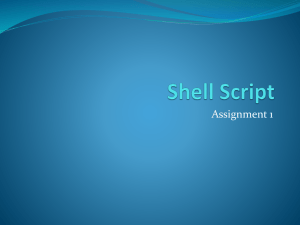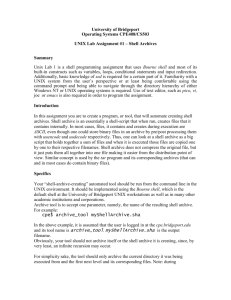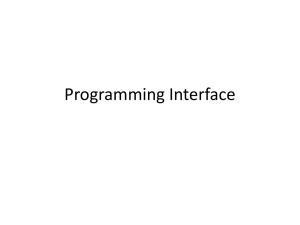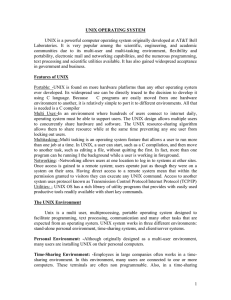unit-3
advertisement
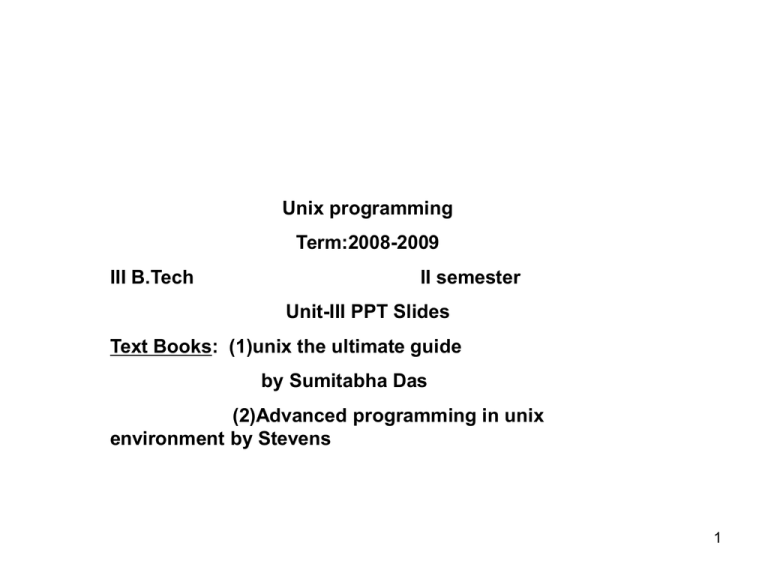
Unix programming Term:2008-2009 III B.Tech II semester Unit-III PPT Slides Text Books: (1)unix the ultimate guide by Sumitabha Das (2)Advanced programming in unix environment by Stevens 1 INDEX UNIT-III PPT SLIDES Srl. No. Module as per Session planner Lecture No. PPT Slide No. 1.Problem solving approaches in Unix ,Using Single command L1 2 2. Using compound command L2 3-12 3. shell scripts L3 13-16 4. C programs ,Building own command library of programs L4 17-18 5. Revision 2 Problem solving approaches in UNIX • Using single command: If only one command is used for solving a problem then the command is known as single Unix command for solving a problem. Eg: $mv file1 file2 $cd /usr/bin This is the simplest approach for solving a problem. 3 Problem solving approaches in UNIX Using compound commands: When a single command is not sufficient to solve a problem, try to join the commands together. Two approaches for this are: • Redirection • Piping 4 Redirection: • Unix commands are built-up in such a way that they can take the input from the keyboard, often called standard input and usually send their output to the screen, often called standard output. Commands also send error information to the screen. • We can also change these defaults by using a process called redirection. 5 • There are three standard files. The shell sets up these three standard files and attaches them to user terminal at the time of logging in. • Standard i/p ----default source is the keyboard. • Standard o/p ----default source is the terminal. • Standard error ----default source is the terminal. 6 Standard i/p: It has three sources • The keyboard, default source • A file using redirection with < • Another program using a pipeline. Eg: $wc or $wc file1 $wc < file1 or $cat file1 | wc 7 Standard o/p: It has 3 destinations. • The terminal, default source • A file using redirection with >, >> • Another program using a pipeline. Using the symbols >,>> u can redirect the o/p of a command to a file. Eg: $cat file1 $cat file1>file2 $who | newfile 8 Standard Error: • When u enter an incorrect command or trying to open a non existing file, certain diagnostic messages show up on the screen. This is the standard error stream. • Trying to cat a nonexistent file produces the error stream. $cat bab Cat: cannot open bab :no such file or directory 9 • The standard error stream can also be redirected to a file. $cat bar 2> errorfile Here 2 is the file descriptor for standard error file. Each of the standard files has a number called a file descriptor, which is used for identification. 0—standard i/p 1---standard o/p 2---standard error 10 Pipes Standard I/p & standard o/p constitute two separate streams that can be individually manipulated by the shell. The shell connects these streams so that one command takes I /p from other using pipes. Command Standard Output | Pipe Standard input Command Who produces the list of users , to save this o/p in a file use $who > user.lst To count the no. of lines in this user.lst use $wc –l <user.lst 11 • Instead of using 2 separate commands we can combine them using pipes. $who | wc –l • Here who is said to be piped to wc. • To count no. of files in current directory $ls | wc –l • There’s no restriction on the no. of commands u can use a pipeline. 12 Shell scripts • All the Unix commands can be entered in the command line itself. When a group of commands have to be executed regularly, they are better stored in a file. All such files are called shell scripts or shell programs. • There’s no restriction on the extension of the file name, though it is helpful to use .sh as the extension. 13 • The following shell script is a sequence of commands: $cat script.sh echo the date today is `date` echo ur shell is $SHELL echo ur home directory is $HOME • U can use vi to create this script. • To execute this script use $sh script.sh or $script.sh 14 Positional parameters: • Shell script accept arguments in another manner-from the command line itself. This is the non interactive method of specifying the command line arguments. • When the arguments are specified with a shell script, they are assigned to certain special variables-rather positional parameters. • The first argument is read by the shell into the parameter $1, second argument into $2 and so on. 15 • The various special parameters used in the script are $1—the first argument $2—the second argument $0—the name of the script $#--the no. of arguments $*--the complete set of positional parameters as a single string. 16 C programs • C is the robust language & most of the Unix is written in c. • C is a compiled language, i.e. u can use one of the system editor to write the program. Then submit this program to C compiler, then run the program. • U can build C programs in Unix also. 17 Steps for writing a C program in UNIX: • Use an editor such as vi, ex or ed to write the program. The file name of the program must end with .c in order to identify it as a C program by the compiler. • Submit the file to C compiler using cc. Eg: $cc filename.c • Run the program using $a.out 18


